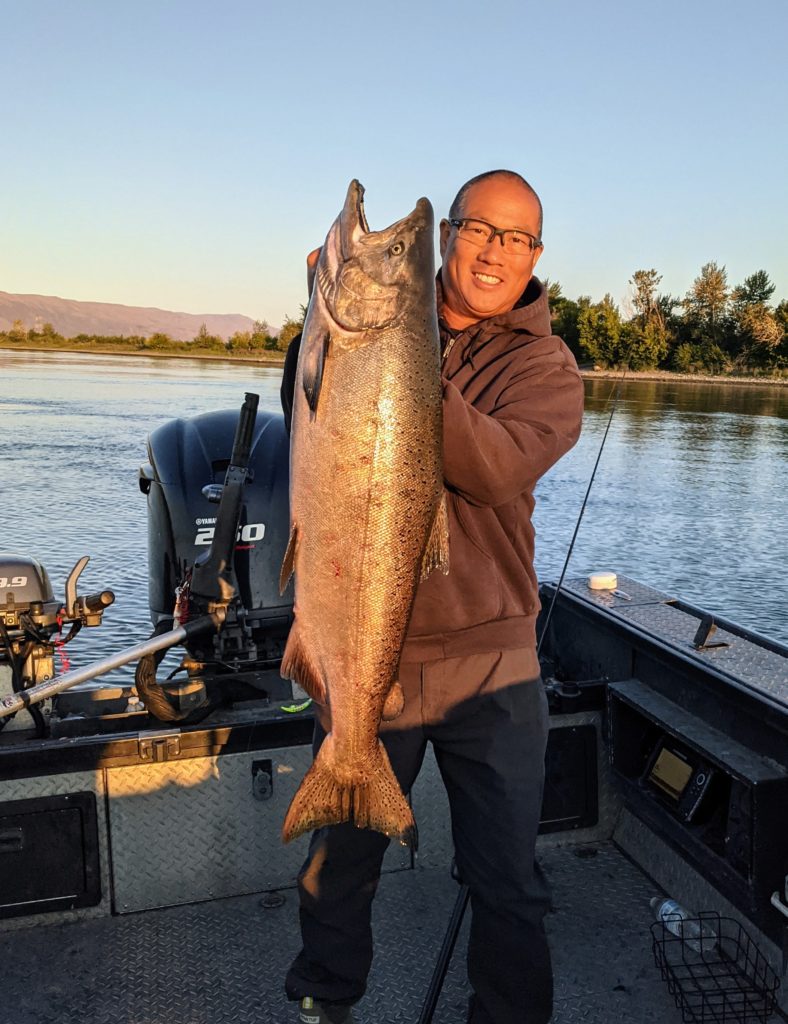
Good Signs On Columbia Fall Kings, Coho; Summer Steelhead Run Upgraded But Still Woeful
There’s some good news on Columbia River fall Chinook, coho and steelhead today from fishery managers, though numbers of that last salmonid species are still in the toilet.

Per a fact sheet out ahead of conference call this morning on a proposed tribal gillnet fishery in gorge pools, not only has the management goal of 60,000 upriver brights at McNary already been met at a point when typically just 20 percent of the run has passed the dam, but the adult king count at Lower Granite on the Snake is the highest through September 8 since the controversial concrete plug went in in the mid-1970s.
What’s more, the coho count at Bonneville through yesterday is the highest for that date all the way back to 1938, when the dam was constructed, a good sign for this year’s monster forecast. Fishing for hatchery silvers at Buoy 10 has been very good, indicating plenty more fish on the way to rivers below, in and above the Columbia Gorge.
And per a technical committee, this year’s A-run of summer steelhead has again been upgraded from the woeful 35,000 of early August – less than half of the poor preseason forecast – to now 47,900, including 30,600 hatcheries and 17,300 wilds.
Since the big river at Bonneville began cooling down from nearly 74 degrees in mid-August to 69 as of yesterday, steelhead counts picked up.
But the running tally at the Columbia’s first dam of 46,847 since July 1 – when counting begins for the stock – is still just 32 percent of the 10-year average and “the lowest count to date” since 1938, per the fact sheet.
In recent weeks managers in Washington, Idaho and Oregon have all issued further steelhead restrictions throughout the watershed in response to concerns. The Lower Columbia from Bonneville to Astoria has also been closed to salmon fishing after Labor Day Weekend in part due to listed tule Chinook catches exceeding expectations. On the flip side, Spring Creek Hatchery is expected to meet its tule needs.
As for the typically bigger and later-returning B-run steelhead, it’s still on the early side to update this year’s expectations, but it’s beginning to look like the forecast of 7,600 will at least be met or beaten, according to the fact sheet.
Here’s the straight scoop from it.
Fall Chinook
• Bonneville Dam passage through September 8 totals 207,896 adult and 33,940 jack fall Chinook. This is the sixth highest cumulative adult count to date in the last 10 years. The clip rate is approximately 57.8%, which is higher than average. Adult passage averages 44.2% complete on September 8.
• Based on sampling by WDFW, the adult counts to date include 157,314 bright stock fish, 35,263 adult tules and 15,317 “stubby” tules which are jack aged fish that grow to just over the adult size criteria for window counts through September 8. The pre-season projection for Spring Creek Tules at Bonneville Dam of 29,150 has been exceeded. Bright stock counts are consistent with the pre-season expectation of 357,360 at Bonneville Dam.
• Spring Creek Hatchery has begun to collect broodstock and has collected over 17,000 fish and will meet its broodstock collection target.
• The adult fall chinook count at McNary Dam through September 8 is 63,547 which is greater than the 60,000 fish management goal. Based on 10-year average run timing the run at McNary Dam would only be 19% complete.
• The Adult chinook count at Lower Granite Dam through September 8 is 11,790. This is the highest count to date since Lower Granite Dam construction. Based on 10-year average run timing the run would be expected to be 15% complete on September 8.
Upriver Summer Steelhead
• Upriver summer steelhead pass Bonneville Dam from April through October of each year. Fish passing during July through October are categorized as A-Index or B-Index based on fork length (A-Index: <78 cm, B-Index: ≥78 cm). Passage during July and early August is primarily A-Index fish; higher levels of B-Index passage normally begins around the end of August. B-Index steelhead primarily return to Snake River tributaries in Idaho can return to any tributary. A-Index steelhead return to tributaries throughout the Columbia and Snake river basins.
• Counts of steelhead at Bonneville Dam since July 1 total 46,847 fish, which is 32% of the recent 10-year average (45% of recent 5-year). It remains the lowest count to date since Bonneville Dam construction. Passage of the total run at Bonneville Dam (July–October) is typically 76% complete by September 8 (recent 10-year average). The count of unclipped steelhead since July 1 totals 18,643 fish. The unclipped run at Bonneville is typically 82.7% complete on September 8 based on 10-year average run timing. The ad-clip rate is 60.2% which is close to average for this period.
• TAC met on September 7 and reviewed information for the summer steelhead run. Passage timing at this point in the run is variable. Based on Bonneville Dam Adult Fish Facility (AFF) sampling through September 3 and the 10-year average run timing, the total A-Index steelhead passage is expected to be 47,900 (30,600 Hatchery A, and 17,300 Wild A steelhead) through October 31. It is too early in the run to update the B-Index component, but based on AFF sampling to date, there is evidence that the B-Index return will meet or exceed the preseason
forecast (7,600 fish).
Coho
• Through September 8 a total of 96,334 adult and 5,606 jack coho have passed Bonneville Dam for this run year. This is the largest count to date since Bonneville Dam construction. The coho run at Bonneville is typically 27.1% complete by this date (38.7% for the early run through September). The adult coho clip rate at Bonneville is 23.7% to date.
